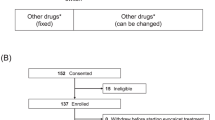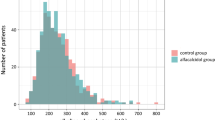Abstract
Calcimimetics suppress the secretion of parathyroid hormone by sensitizing the parathyroid calcium receptor to serum calcium. Cinacalcet (Sensipar®/Mimpara®, Amgen Inc., Thousand Oaks, CA), the first-in-class calcimimetic agent approved for treatment of secondary hyperparathyroidism in dialysis patients, is, in association with higher dose of a calcium-based oral phosphate binder, a well-tolerated and effective alternative to standard treatments such as vitamin D derivatives in association with a non-calcium-based oral phosphate binder. Here, we present an overview of evidence in support of this assertion. We extend our discussion to encompass other indications for calcimimetics—secondary hyperparathyroidism in predialysis chronic kidney disease patients, hypercalcemic hyperparathyroidism in renal transplant recipients, primary hyperparathyroidism, and hypercalcemia associated with parathyroid carcinoma—as well as providing guidance on optimal usage of this drug.
Key Points
-
Calcimimetic drugs such as cinacalcet (Sensipar®/Mimpara®, Amgen Inc., Thousand Oaks, CA) suppress secretion of parathyroid hormone by sensitizing calcium receptors to extracellular ionized calcium
-
Cinacalcet has been approved for treatment of dialysis patients with secondary hyperparathyroidism
-
Cinacalcet is a safe, efficacious and cost-effective alternative to currently recommended drug regimens (e.g. vitamin D derivatives plus non-calcium-based oral phosphate binders)
-
Some data support use of calcimimetics to manage predialysis secondary hyperparathyroidism, hypercalcemic hyperparathyroidism in kidney graft recipients, primary hyperparathyroidism and parathyroid carcinoma
This is a preview of subscription content, access via your institution
Access options
Subscribe to this journal
Receive 12 print issues and online access
$209.00 per year
only $17.42 per issue
Buy this article
- Purchase on Springer Link
- Instant access to full article PDF
Prices may be subject to local taxes which are calculated during checkout
Similar content being viewed by others
References
Hofer AM and Brown EM (2003) Extracellular calcium sensing and signalling. Nat Rev Mol Cell Biol 4: 530–538
Nemeth EF et al. (2004) Pharmacodynamics of the type II calcimimetic compound cinacalcet HCl. J Pharmacol Exp Ther 308: 627–635
Shahapuni I et al. (2005) How do calcimimetics fit into the management of parathyroid hormone, calcium, and phosphate disturbances in dialysis patients? Semin Dial 18: 226–238
Lindberg JS (2005) Calcimimetics: a new tool for management of hyperparathyroidism and renal osteodystrophy in patients with chronic kidney disease. Kidney Int 67: 533–536
Block GA et al. (2004) Cinacalcet for secondary hyperparathyroidism in patients receiving hemodialysis. N Engl J Med 350: 1516–1525
Moe SM et al. (2005) Achieving NKF-K/DOQI bone metabolism and disease treatment goals with cinacalcet HCl. Kidney Int 67: 760–771
Malluche M et al. (2004) Cinacalcet HCl reduces bone turn over and bone marrow fibrosa in hemodialysis patients with secondary hyperparathyroidism. In Abstract Book from ERA-EDTA XLI congress: 2004 May 15–18; Lisbon, P218 (M016)
Urena P and Torres A (2004) Clinical experience with cinacalcet HCl. Nephrol Dial Transplant 19: V27–33
Cunningham J et al. (2005) Effects of the calcimimetic cinacalcet HCl on cardiovascular disease, fracture, and health-related quality of life in secondary hyperparathyroidism. Kidney Int 68: 1793–1800
Ogata H et al. (2003) Beneficial effects of calcimimetics on progression of renal failure and cardiovascular risk factors. J Am Soc Nephrol 14: 959–967
Porsti I et al. (2004) High calcium diet down-regulates kidney angiotensin-converting enzyme in experimental renal failure. Kidney Int 66: 2155–2166
Cozzolino M et al. (2003) Sevelamer hydrochloride attenuates kidney and cardiovascular calcifications in long-term experimental uremia. Kidney Int 64: 1653–1661
Phan O et al. (2004) Sevelamer prevents accelerated atherosclerosis in apolipoprotein E deficient (apoE-/-) mice with chronic renal failure (CRF) [abstract]. J Am Soc Nephrol 15: 275A (Poster FPO962)
Henley C et al. (2005) 1,25 OH vitamin D but not cinacalcet treatment mediates aortic calcification in a rat model of secondary hyperparathyroidism. Nephrol Dial Transplant 20: 1370–1377
Haffner D et al. (2005) Systemic cardiovascular disease in uremic rats induced by 1,25(OH)2D3. J Hypertens 23: 1067–1075
Fournier A et al. (2004) Cinacalcet HCl reduces parathyroid hormone and calcium phosphorus product regardless of concurrent changes in vitamin D administration. In Abstract Book from ERA-EDTA XLI congress: 2004 May 15–18; Lisbon, 319
Mansour J et al. (2003) Calcimetic AMG 073 at 50 and 100 mg per day. Kidney Int 64: 2324–2325
Lindberg JS et al. (2003) The calcimimetic AMG 073 reduces parathyroid hormone and calcium × phosphorus in secondary hyperparathyroidism. Kidney Int 63: 248–254
Quarles LD et al. (2003) The calcimimetic AMG 073 as a potential treatment for secondary hyperparathyroidism of end-stage renal disease. J Am Soc Nephrol 14: 575–583
Chertow GM et al. (2002) Sevelamer attenuates the progression of coronary and aortic calcification in hemodialysis patients. Kidney Int 62: 245–252
Manns B et al. (2004) A systematic review of sevelamer in ESRD and an analysis of its potential economic impact in Canada and the United States. Kidney Int 66: 1239–1247
Slatopolsky E and Bricker NS (1973) The role of phosphorus restriction in the prevention of secondary hyperparathyroidism in chronic renal disease. Kidney Int 4: 141–145
Charytan C et al. (2005) Cinacalcet hydrochloride is an effective treatment for secondary hyperparathyroidism in patients with CKD not receiving dialysis. Am J Kidney Dis 46: 58–67
Mizobuchi M et al. (2004) Calcimimetic compound upregulates decreased calcium-sensing receptor expression level in parathyroid glands of rats with chronic renal insufficiency. J Am Soc Nephrol 15: 2579–2587
Ritter CS et al. (2002) Reversal of secondary hyperparathyroidism by phosphate restriction restores parathyroid calcium-sensing receptor expression and function. J Bone Miner Res 17: 2206–2213
LaClair RE et al. (2005) Prevalence of calcidiol deficiency in CKD: a cross-sectional study across latitudes in the United States. Am J Kidney Dis 45: 1026–1033
Holick BW (2004) The determination of circulating 25-hydroxyvitamin D: no easy task. J Clin Endocrinol Metab 89: 3149–3151
Fournier A et al. (1988) Preventing renal bone disease in moderate renal failure with CaCO3 and 25(OH) vitamin D3. Kidney Int Suppl 24: S178–S179
Hamdy NA et al. (1995) Effect of alfacalcidol on natural course of renal bone disease in mild to moderate renal failure. BMJ 310: 358–363
Ritz E et al. (1995) Low-dose calcitriol prevents the rise of 1-84 PTH without affecting serum calcium and phosphate in patients with moderate renal failure. Nephrol Dial Transplant 10: 2228–2234
Lafage MH et al. (1992) Ketodiet, physiological calcium intake and native vitamin D improve renal osteodystrophy. Kidney Int 42: 1217–1225
Takahashi Y et al. (2004) Nicotinamide suppresses hyperphosphatemia in hemodialysis patients. Kidney Int 65: 1099–1104
Capuzzi DM et al. (1998) Efficacy and safety of an extended-release niacin (Niaspan): a long-term study. Am J Cardiol 82: 74U–81U
Gale AM for the ENDIT group (2004) European Nicoticotinamide Diabetes Intervention Trial (ENDIT): a randomised controlled trial of intervention before the onset of type I diabetes. Lancet 363: 925–931
Rottembourg JB et al. (2005) Thrombocytopenia induced by nicotinamide in hemodialysis patients. Kidney Int 68: 2911–2912
Combe C and Aparicio M (1994) Phosphorus and protein restriction and parathyroid function in chronic renal failure. Kidney Int 46: 1381–1386
Lafage Proust M et al. (1999) Bone mass and dynamic parathyroid function according to bone histology in non dialyzed uremic patients after long term protein and phosphorus resctriction. J Clin Endocrinol Metab 84: 512–519
Evenepoel P et al. (2005) Impact of parathyroidectomy on renal graft function, blood pressure and serum lipids in kidney transplant recipients: a single center study. Nephrol Dial Transplant 20: 1714–1720
Kruse AE et al. (2005) The calcimimetic cinacalcet normalizes serum calcium in renal transplant with persistent hyperparathyroidism. Nephrol Dial Transplant 20: 1311–1314
Serra AL et al. (2005) Successful treatment of hypercalcemia with cinacalcet in renal transplant recipients with persistent hyperparathyroïdism. Nephrol Dial Transplant 20: 1315–1319
Bilezikian J et al. (2002) Summary statement from a workshop asymptomatic primary hyperparathyroidism: a perspective for the 21st century. J Bone Miner Res 17: N2–N11
Souberbielle JC et al. (2003) The use in clinical practice of parathyroid hormone normative values established in vitamin D-sufficient subjects. J Clin Endocrinol Metab 88: 3501–3504
Kolta S et al. (2000) Follow-up of individual patients on two DXA scanners of the same manufacturer. Osteoporos Int 11: 709–713
Shoback D et al. (2003) The calcimimetic cinacalcet normalizes serum calcium in subjects with primary hyperparathyroidism. J Clin Endocrinol Metab 88: 5644–5649
Peacock M et al. (2005) Cinacalcet hydrochloride maintains long-term normocalcemia in patients with primary hyperparathyrodism. J Clin Endocrinol Metab 90: 135–141
Khosla S and Melton LR (2002) Fracture risk in primary hyperparathyroidism. J Bone Miner Res 17 (Suppl 2): N103–N107
Heaney R (2002) The basis of the post parathyroidectomy increase in bone mass. J Bone Miner Res 17 (Suppl 2): N154–N157
Marx S (2003) Familial hypocalciuric hypercalcemia. In Primer on the Metabolic Bone Diseases and Disorders of Mineral Metabolism, 239–241 (Ed. Favus M) Philadelphia: Lippincott, Williams & Wilkins
Collins M et al. (1998) Treatment of hypercalcemia secondary to parathyroid carcinoma with a novel calcimimetic agent. J Clin Endocrinol Metab 83: 1083–1088
Pearce S et al. (1996) A familial syndrome of hypocalcemia with hypercalciuria due to mutations in the calcium-sensing receptor. N Engl J Med 335: 1115–1122
Peacock M (2002) Normalization of hypercalcemia with calcimimetic AMG073 in a patient with metastatic parathyroid cancer. J Bone Miner Res 17: S381
Silverberg S et al. (2003) The effects of cinacalcet HCl (AMG073) on serum calcium levels in patients with parathyroid carcinoma or recurrent primary hyperparathyroidism after parathyroidectomy. J Bone Miner Res 18 (Suppl): S171
Amgen Inc. (online 2005) Cinacalcet (Sensipar®): US prescribing information [http://www.sensipar.com] (accessed May 27 2005)
Thervet E et al. (2005) Cytochrome P450 3A polymorphisms and immunosuppressive drugs. Pharmacogenomics 6: 37–47
Author information
Authors and Affiliations
Corresponding author
Ethics declarations
Competing interests
The authors declare no competing financial interests.
Rights and permissions
About this article
Cite this article
Shahapuni, I., Monge, M., Oprisiu, R. et al. Drug Insight: renal indications of calcimimetics. Nat Rev Nephrol 2, 316–325 (2006). https://doi.org/10.1038/ncpneph0191
Received:
Accepted:
Issue Date:
DOI: https://doi.org/10.1038/ncpneph0191
This article is cited by
-
Calcimimetics in chronic kidney disease: evidence, opportunities and challenges
Kidney International (2008)
-
Calcium-sensing receptor
AfCS-Nature Molecule Pages (2008)



